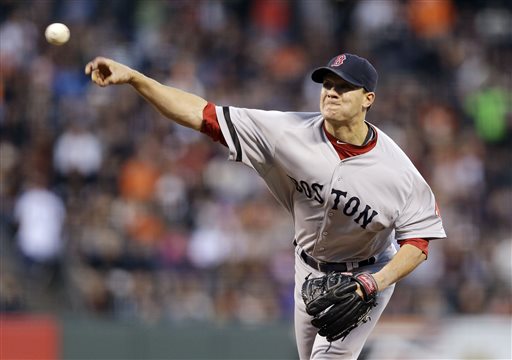BOSTON — Don’t expect a sentimental reunion when Boston plays the Los Angeles Dodgers this weekend and visits former Red Sox Adrian Gonzalez, Carl Crawford and the injured Josh Beckett.
But don’t expect a lot of regrets, either.
Almost a year after the trade that sent the three high-priced and under-performing players – along with Nick Punto – to the Dodgers, both teams are in the playoff hunt and perfectly content with the Aug. 25, 2012, blockbuster.
For Los Angeles, the deal was the start of a TV revenue-fueled spending spree that formed the foundation of a contender. For the Red Sox, it was a clean break with the free agency extravagance that contributed to their unprecedented collapse in September of 2011, followed by a 2012 season that was the worst for the franchise in half a century.
As the Red Sox head to Los Angeles for a three-game series against the Dodgers, here are five things we’ve learned since the trade:
Addition by subtraction: The Red Sox didn’t get much in terms of players in the deal — James Loney was the only established major leaguer coming to Boston, and he left after the season — but they were benefited by shedding salary: Beckett was due $31.5 million from 2013-14, Gonzalez had $127 million coming through 2018, and Crawford was due $102.5 million over five seasons. In all, the Red Sox saved more than a quarter of a billion dollars through ’18.
Spend it wisely: The Red Sox learned that a high payroll isn’t worth much if the money isn’t spent well. They appear to have done that this offseason, replacing the departed players with free agent outfielders Shane Victorino and Jonny Gomes, first baseman Mike Napoli, and starter Ryan Dempster. Total cost for those players: about $36 million for this year and $80 million total.
Flexibility: Thanks to the salary dump, the Red Sox payroll dropped from about $173 million to about $150 million this season, giving the team the flexibility to add free agents but also allowing it to acquire right-hander Jake Peavy at this year’s trade deadline. Peavy could be a key down the stretch; so far, Boston is 1-3 in games he has started but two of the losses were by scores of 3-2 and 2-1. He has had only one bad start.
Be patient: To start, it was a trade that hurt both teams. The Red Sox continued their descent to the bottom of the AL East, and manager Bobby Valentine was fired. And it didn’t exactly do wonders for the Dodgers, who were 11 games above .500 when the players arrived on Aug. 26 and finished the year with 10 more wins than losses, eight games back in the NL West and two games behind the second wild-card team. But this season they are both leading their division heading into the weekend series – the Dodgers by a whopping 9½ games.
The future: This was expected to be a year for the Red Sox to regain their footing under new manager John Farrell. But they have already surpassed last year’s total of 69 wins and, tied with the Dodgers for the second-most wins in all of baseball, look to be a threat this postseason. That is a bonus that obscures the true benefit of the trade: They are committed to just over $100 million for next season, and have an opportunity to be big players in the free agent market for years to come.
Assuming, that is, that they spend their money wisely.
Send questions/comments to the editors.



Success. Please wait for the page to reload. If the page does not reload within 5 seconds, please refresh the page.
Enter your email and password to access comments.
Hi, to comment on stories you must . This profile is in addition to your subscription and website login.
Already have a commenting profile? .
Invalid username/password.
Please check your email to confirm and complete your registration.
Only subscribers are eligible to post comments. Please subscribe or login first for digital access. Here’s why.
Use the form below to reset your password. When you've submitted your account email, we will send an email with a reset code.